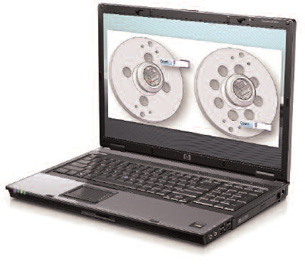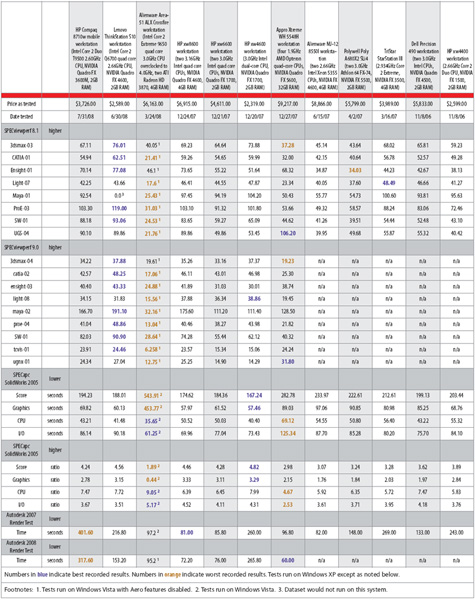The New HP Compaq 8710w is Actually a Workstation
New HP high-end laptop achieves true workstation performance using the new NVIDIA Quadro FX 3600M.
December 4, 2001
By David Cohn
 The HP Compaq 8710w looks very similar to the Compaq nw9440, measuring an identical 15.5 in.x 10.8 in. x 1.3 in. and tipping the scales at the same 7.5 lbs. Inside, though, it’s quite different. |
If you’ve ever wondered whether a laptop computer could really replace that big workstation next to your desk, wonder no more. We just received the latest version of HP’s top-of-the-line mobile workstation — the Compaq 8710w — and our test results were amazing.
The 8710w is the successor to HP’s nw9440 (see August 2006 DE). It’s the larger of two models aimed at developers, engineers, designers, and animators who need the ultimate in graphics plus ISV certifications and a large display. The smaller 8510w has a 15.4-in. LCD while the 8710w comes with a 17-in. panel that is nothing short of stunning. Both are powered by Intel Core 2 Duo CPUs and have been on the market for a while.
But earlier this year, NVIDIA released its Quadro FX 3600M GPU for notebook and laptop workstations and HP was quick to offer the new graphics processor in the 8710w.
Outside & In
The HP Compaq 8710w looks very similar to its predecessor, measuring an identical 15.5 in. x 10.8 in. x 1.3 in. and tipping the scales at the same 7.5 lbs., plus the power supply. The power supply itself was the first surprise when we opened the shipping box, because we received two power supplies: a large (6.5 in. x 2.5 in. x 1.5 in.; 1.75 lbs.) 135W AC adapter and an even bigger (6.5 in. x 3.25 in. x 1.5 in.; 2.5 lbs.) 180W adapter. With the addition of the NVIDIA FX 3600M GPU, the system requires more power than the original 120W power supply that shipped with earlier 8710w models. For those who purchase an optional docking station, the AC adapter provided with the docking station also needs to be upsized, thus the inclusion of the 180W adapter.
Raising the lid on the dark-gray slim-profile case reveals a full-size keyboard and full-size numeric keypad with a large palm-rest area. There’s also a pointing stick with three mouse buttons and a touchpad with a scroll area along its right edge that duplicates the roller wheel on a mouse, as well as three additional buttons. The HP fingerprint sensor, which took the place of the touchpad’s middle mouse button on the nw9440, is now located in the lower-right corner of the palm rest.
 |
Controls, Displays, & Drive
The system’s speakers, powered by a high-definition 24-bit audio chipset, are located on the front edge. Touch-sensitive controls within a strip above the keyboard let you adjust volume or mute the audio entirely while lights indicate keyboard caps and number lock. There’s also a touch-sensitive button above the numeric keypad that opens the Windows Calculator. Other touch-sensitive buttons within the strip toggle the system’s wireless functions, display the HP Info Center dialog (which provides quick access to online documentation), and let you configure video and power settings and then activate a predefined presentation.
While the full-size keyboard and numeric keypad are nice, the real reason for the large size of the 8710w is the 17-in. wide-aspect display. HP offers three different display options ranging from 1680x1050 WSXGA+ (with either an anti-glare screen as in our evaluation unit or an optional BrightView panel) or a 1920x1200 WUXGA anti-glare display (only $75 more). An ambient light sensor can automatically adjust the LCD backlight for optimal viewing in different lighting conditions.
The NVIDIA Quadro FX 3600M GPU comes with 512MB of dedicated graphics memory and can also power an external monitor at up to 2048x1536. With an optional docking station, the system supports dual-link DVI monitors up to 2560x1600. The graphics subsystem uses a 256-bit memory interface, has a 51.2GBps graphic memory bandwidth, and supports OpenGL 2.1, Shader Model 4.0, and DirectX 10, the same specs as the NVIDIA Quadro FX 3700.
HP offers several hard-drive options, including 5400rpm drives ranging from 120GB up to 250GB as well as faster 7200rpm drives of up to 200GB capacity. Our evaluation unit came with a smaller 80GB 7200rpm Hitachi Travelstar drive. Optical drive options range from a standard DVD to a Blu-Ray DVD+/-RW dual-layer drive (a $575 option). Plus, our evaluation unit was equipped with a LightScribe DVD+/-RW dual-layer drive.
 |
Ports & No Ports
The expansion ports on the 8710w follow the same logical arrangement that we’ve long praised in previous HP mobile workstations. Along the right side of the case are headphone and microphone jacks, four USB 2.0 ports, the optical drive, RJ11 modem port, and RJ45 network connector. Along the left side are a Type I/II PC Card slot, Smart Card reader, 1394a (FireWire) connector, two additional USB ports, 15-pin VGA external monitor connector, HDMI 1.2 high definition video/audio port (with support for HD displays up to 1920x1080 resolution and 7-channel audio), power connector, and a Kensington lock slot. In addition to the aforementioned stereo speakers, the front of the case houses a media card reader that handles SD, MMC, Memory Stick, Memory Stick Pro, Memory Stick Duo, and xD-Picture cards. Individual LEDs along the front edge also show WiFi, power, battery charging, and hard-drive activity and remain visible even when the case is closed. Icons around the top edge of the system make it easy to identify each of these connections, a simple but effective touch that no one other than HP provides.
There are no ports at all on the back of the system, this area being used instead by the 8-cell 73WHr lithium-ion battery and a cooling vent. The bottom of the case provides access to the battery release latches, docking port connector, optional accessory battery connector, and internal components such as the hard drive and memory modules. There’s also a business card holder on the bottom of the case, a handy addition to help prevent confusion at airport security screenings.
HP has really done wonders managing power consumption. Even with the increased demands of the NVIDIA Quadro FX 3600M GPU, the standard battery kept the system up and running for 2.5 hours. HP also sells several optional add-on batteries, including a $209 wedge-shaped 12-cell 95WHr ultra-capacity battery that can increase total battery life to as long as nine hours.
Amazing Benchmark Results
HP offers the 8710w in several different configurations, with CPUs ranging from a 1.8GHz Intel Core 2 Duo processor up to the Model T9500 2.6GHz dual-core CPU in our evaluation unit. All of these processors feature an 800MHz front-side bus and are supported by the Intel PM965 chipset, but the T9500 has 6MB of L2 cache. You can equip the system with anywhere from 1 to 8GB of 667MHz DDR2 SDRAM memory using SODIMM modules in the two memory slots. Our evaluation unit came with 2GB of RAM installed as a single memory module.
We downloaded the latest version of the NVIDIA graphics driver available from the HP website and then ran our now-standard set of benchmark tests, including SPECviewperf to measure graphics performance and the SPECapc benchmark for SolidWorks to gauge how the computer performs running a typical MCAD application. We also ran our AutoCAD rendering test using both AutoCAD 2007 and 2008 (see table).
Although we certainly didn’t expect the 8710w to beat any of the full-blown workstations we’ve recently reviewed, we weren’t prepared for how close the results actually were. In terms of graphics performance, the FX3600M-equipped 8710w equaled or exceeded the performance of several of the workstations. Even the SolidWorks results were quite good overall, but here the CPU and I/O results lagged considerably behind the workstations, which was to be expected.
It was only on the AutoCAD rendering test that we were reminded that this was a mobile workstation after all. The HP Compaq 8710w lagged behind the workstations, taking nearly 5.5 minutes to render our test image at 1280x1024, more than a minute longer than the HP wx4600 workstation equipped with a 3.0GHz dual-core CPU. Still, that’s not bad — 16 percent longer to render the image using a CPU that’s 13 percent slower than its workstation competition. We can only imagine what the performance will be like when Intel begins shipping quad-core versions of its mobile CPUs (rumored to be enroute).
While all of this power doesn’t come cheap — our evaluation unit would set you back $3,726 as tested — that’s not bad considering the price of a comparably equipped workstation. Prices for the HP Compaq 8710w start at $2,229, but we’d definitely recommend moving well up the model chain, including increasing the size of the hard drive and opting for more memory, particularly if you’re considering a move to a 64-bit operating system. A similar system, with 4GB of memory, a 1920x1200 display, and a 200GB 7200rpm drive would cost $4,156. HP backs the 8710w with a three-year onsite warranty plus a one-year warranty on the battery. Warranty upgrades are also available. The system is fully certified for most CAD and DCC applications.
With the inclusion of the NVIDIA Quadro FX 3600M graphics controller, this mobile workstation reaches near parity with its desktop brethren. The HP Compaq 8710w clearly earns the workstation imprimatur. The only question you need ask yourself now is whether that mobility is worth the premium price. For many technical professionals on the go, the answer is an obvious yes.
More Info:
HP
Houston,TX
HP Compaq 8710w
>Price: $3,726 as tested ($2,229 base price)
>Size: 15.5 in. x 10.8 in. x 1.3 in. (WxDxH) notebook
>Weight: 7.5 lbs plus power supply (depending on configuration)
>CPU: 2.6GHz Intel Core 2 Duo (T9500) w/6MB L2 cache
>Memory: 2GB (8GB max)
>Graphics: NVIDIA Quadro FX 3600M w/512MB memory
>LCD: 17.0 in. WSXGA+ 1680x1050
>Hard Disk: 80GB, 7200rpm Smart SATA
>Floppy: none
>Optical: LightScribe DVD+/-RW with Double Layer
>Audio: microphone and headphone jacks, built-in microphone and speakers
>Network: integrated 10/100/1000 Ethernet, 102.11 a/b/g wireless LAN, Bluetooth
>Modem: 56K V.92 Modem
>Other: six USB 2.0, one mini IEEE 1394 Firewire, HDMI video/audio out, Media Card reader (SD, MMC, MS, MS/Pro, MS/Duo, XD), one Type I/II PC Card slot, 15-pin VGA
>Keyboard: integrated 101-key keyboard incl. numeric keypad
>Pointing device: integrated 3-button touchpad and pointing stick, fingerprint reader
Contributing Editor David Cohn is a computer consultant and technical writer based in Bellingham,WA, and has been benchmarking PCs since 1984. He’s an applications engineer with The PPI Group, and the author of more than a dozen books. Please send comments about this article to [email protected]. You can also contact David at [email protected].
Subscribe to our FREE magazine, FREE email newsletters or both!
About the Author
David Cohn is a consultant and technical writer based in Bellingham, WA, and has been benchmarking PCs since 1984. He is a Contributing Editor to Digital Engineering, the former senior content manager at 4D Technologies, and the author of more than a dozen books. Email at [email protected] or visit his website at www.dscohn.com.
Follow DE





